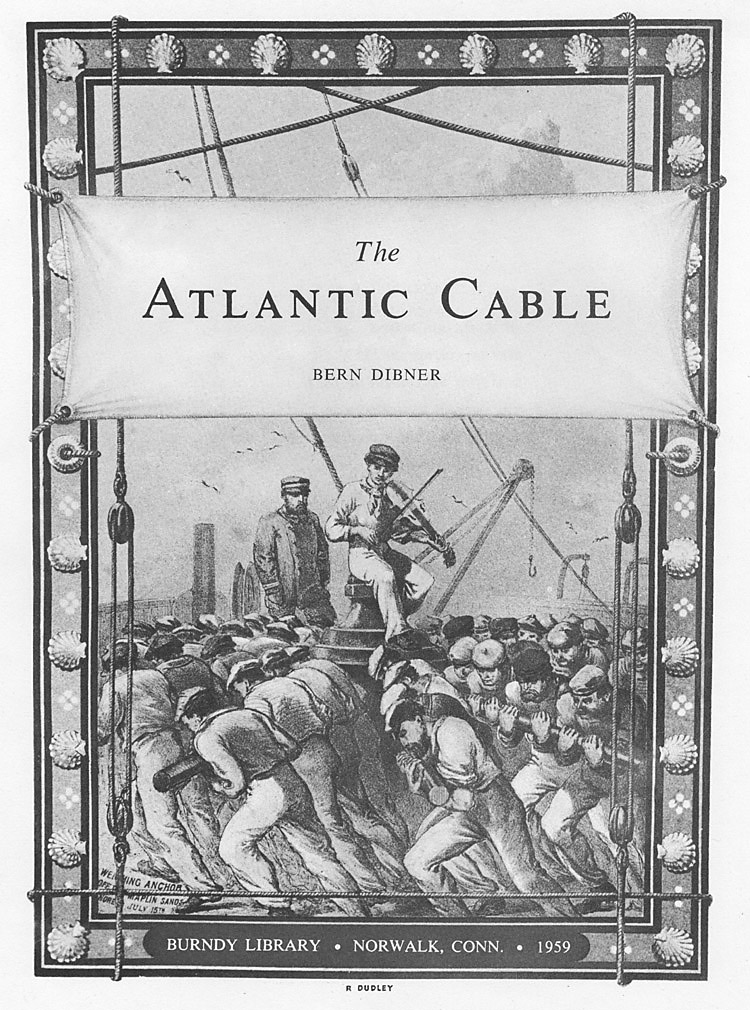Bern Dibner: The Atlantic Cable (1959)
Filed under book | Tags: · history of science, history of technology, science, technology, telegraphy

“Bern Dibner wrote a lucid chronological history of the laying of the Atlantic Cable. He covers the early experiments of Morse in New York Harbor in 1842; Ezra Cornell’s laying of a line across the Hudson River in 1845; the five actual attempts at laying the cable; and the eventual success in completing two telegraph circuits connecting Newfoundland and Ireland in 1866.
Cyrus Field was, in the words of William Thomson (later Lord Kelvin), the “originator and mainspring” of the project, which was regarded as foolhardy in many quarters. At the outset in 1854, Field realized that many electrical, mechanical, oceanographical, and nautical problems would have to be solved. Having sought and obtained encouragement of specialists in each of these areas, he was able to raise the necessary capital to finance the design, manufacture, transportation, and laying of the submarine telegraph cable. Field did not foresee, however, that the enterprise would take twelve years and forty long, hazardous trans-Atlantic crossings (the first by sailing vessel); that it woudl touch the fields of science, politics, finance, and geography; and that it would cost $12,000,000.
This book makes clear the roles of Field and Morse and Thomson, of the ships’ captains and the financial backers, and of all those who played a part in the courageous undertaking.” (source)
Publisher Burndy Library, Norwalk/Connecticut, 1959
96 pages
via Smithsonian Libraries
Videos about the transatlantic telegraph cable (via Marcell Mars):
The Great Transatlantic Cable (PBS, 120 min), torrent
Modern Marvels S01E06 – Transatlantic Cable (44 min)
History Detectives – Transatlantic Cable (PBS, 16 min)
PDF (no OCR)
Comment (0)Liu, Mowitt, Pepper, Spicer (eds.): The Dreams of Interpretation: A Century Down the Royal Road (2007)
Filed under book | Tags: · desire, dreams, hermeneutics, psychoanalysis, psychology

Rethinking the importance of Sigmund Freud’s landmark book The Interpretation of Dreams a century after its publication in 1900, this work brings together psychoanalysts, philosophers, cultural theorists, film and visual theorists, and literary critics from several continents in a compilation of the best clinical and theoretical work being done in psychoanalysis today. It is unique in convening both theory and practice in productive dialogue, reflecting on the encounter between psychoanalysis and the tradition of hermeneutics. Collectively the essays argue that Freud’s legacy has shaped the way we think about not only psychology and the nature of the self but also our understanding of politics, culture, and even thought itself.
Contributors: Willy Apollon, Gifric; Karyn Ball, U of Alberta, Edmonton; Raymond Bellour, Centre National de la Recherche Scientifique; Patricia Gherovici, Philadelphia Lacan Study Group and Seminar; Judith Feher-Gurewich, New York U; Jonathan Kahana, New York U; A. Kiarina Kordela, Macalester College; Pablo Kovalovsky, Clinica de Borde; Jean Laplanche, U of Lausanne; Laura Marcus, U of Sussex; Andrew McNamara, Queensland U of Technology; Claire Nahon; Yun Peng, U of Minnesota; Gerard Pommier, Nantes U; Jean-Michel Rabaté, U of Pennsylvania; Laurence A. Rickels, U of California, Santa Barbara; Avital Ronell, New York U; Elke Siegel, Yale U; Rei Terada, U of California, Irvine; Klaus Theweleit, U of Freiburg-im-Breisgau; Paul Verhaege, U of Ghent, Belgium; Silke-Maria Weineck, U of Michigan.
Edited by Catherine Liu, John Mowitt, Thomas Pepper, and Jakki Spicer
Publisher University of Minnesota Press, 2007
Cultural Critique Books series
ISBN 0816647992, 9780816647996
379 pages
review (Louis Rose, Medical History)
Comment (0)Ray Monk: Inside the Centre: The Life of J. Robert Oppenheimer (2012)
Filed under book | Tags: · biography, history of science, science

J. Robert Oppenheimer is among the most contentious and important figures of the twentieth century. As head of the Los Alamos Laboratory, he oversaw the successful effort to beat the Nazis to develop the first atomic bomb – a breakthrough which was to have eternal ramifications for mankind, and made Oppenheimer the ‘father of the Bomb’.
Oppenheimer was a man of diverse interests and phenomenal intellectual attributes. His talent and drive allowed him as a young scientist to enter a community peopled by the great names of twentieth-century physics – men such as Bohr, Born, Dirac and Einstein – and to play a role in the laboratories and classrooms where the world was being changed forever.
But Oppenheimer’s was not a simple story of assimilation, scientific success and world fame. A complicated and fragile personality, the implications of the discoveries at Los Alamos were to weigh heavily upon him. Having formed suspicious connections in the 1930s, in the wake of the Allied victory in World War Two, Oppenheimer’s attempts to resist the escalation of the Cold War arms race would lead many to question his loyalties – and set him on a collision course with Senator Joseph McCarthy and his witch hunters.
As with Ray Monk’s peerless biographies of Wittgenstein and Bertrand Russell, Inside the Centre is a work of towering scholarship. A story of discovery, secrecy, impossible choices and unimaginable destruction, it goes deeper than any previous work in revealing the motivations and complexities of this most brilliant and divisive of men.
Publisher Jonathan Cape, an imprint of Random House, London, 2012
ISBN 022406262X, 9780224062626
818 pages
review (Miranda Carter, The Telegraph)
review (John Gray, Literary Review)
review (Martin Underwood, The British Journal for the History of Science)
Oppenheimer’s life in 600 tweets (?!)
publisher
google books
PDF (MOBI)
Comment (0)
